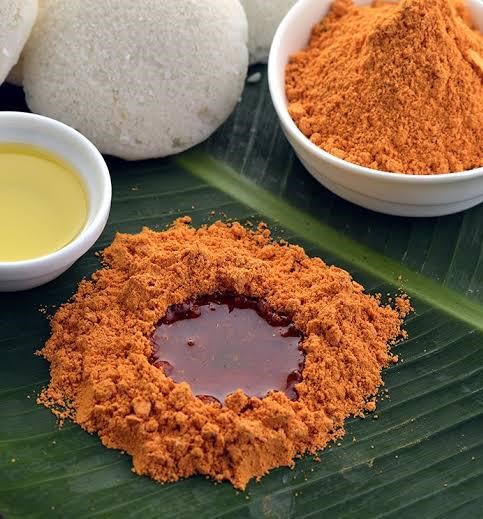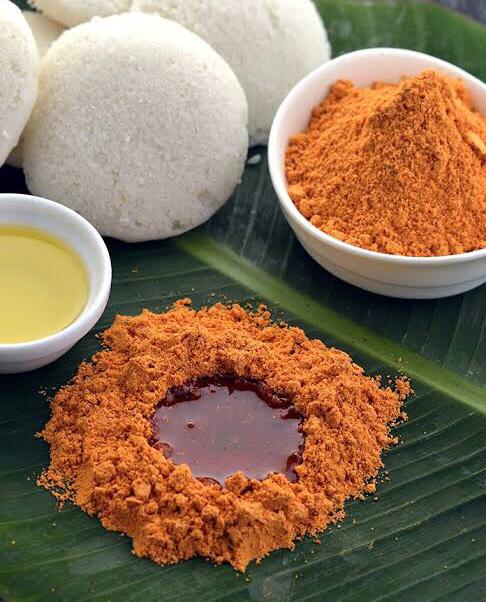“They don’t make them like they used to anymore”, these were Sister Sarah’s words as she sat there explaining the details of how podi is usually made. With closed eyes I try to imagine strong hands holding the ooral ulaekkai slowly adding the two-day old sun dried curry leaves. These leaves are then lightly fried in gingelly oil hot from the pan, into the traditional stone grinder they are mixed with the vibrant colourful mashed spices, dals and chilli.
Sitting at the dining table, I open my eyes and stare at my tiny hands. Through the space between my fingers, I see the stainless steel plate holding my dinner for the night. White rubbery idlis with chicken curry and a selection of podis all given to us by different neighbouring homes. Small towns and tiny villages secluded in rural Tamil Nadu are quaint places where everybody knows everything about everyone. It took little to no time for people around us to figure out that Ma doesn’t cook all that much for us.
“Kutti papa, papa saapaad saptiya?” (Child, have you eaten your food?) is the most common thing I am asked on a regular basis. Sending food for “madam” and her daughter has become a frequent routine where I live. The second most common thing said to me is that I need to eat more because I am too tiny and slim, something I have heard all my life. I suppose in that way I can relate to all the ingredients that are added to make podi.
These small, tiny ingredients such as dal, black pepper balls and herbs are crushed into even smaller morsels, just like my tiny human self is examined and crushed into fragments of shattered ego based on my looks and body image. These ingredients are then turned into powdered goodness ready to be used on literally anything. Watching Ma soak a bowl full of dates, one day, I asked her naively, “Why do they call podi, gunpowder?”. She told me it’s because they are meant to be spicy. Now follow the train of thought with me Spicy = Hot = Fiery = Fire = British commanders screaming “fire!” at unfortunate colonized Indians therefore, gunpowder = Podi.
I wonder if podis existed before the British arrived, it most probably did and then, one day a British officer had some podi and must have said it tasted like gunpowder. Snapping back to reality I look at my plate, therein lies my beautiful blob of ghee. My favorite part about eating podi isn’t eating the podi itself but taking my little finger and making an inner circled partition inside the blob of ghee and adding the podi in the gap like a tiny podi island surrounded by ghee. Then taking my index finger I slowly allow the ghee to infiltrate the podi and then swirl them together bit by bit until the ghee has been completely flooded in and there is no island anymore. The podi is a part of the ghee and ghee is a part of the podi. It’s a soft grainy paste that I dip my dosa or idli into. If Idli and podi are a match made in heaven, hot soft rice mixed with podi with the oil of your choice is the steamy affair to be remembered. Dosa and podi are arranged marriages – safe, boring, predictable, they work for some people and don’t for others.
I asked Sister Sarah where and who she learnt to make podi from and she told me that her mother taught her how to make them and that she learned it only after she got married. Almost like a rite of passage; the ability to make tasty podi inversely proportional to what a good homemaker you are. Being a good homemaker is important where I live. It is far more important than anywhere else I have witnessed. Girls from the impressionable ages of 6 are taught to clean houses, wash dishes and learn how to cook, no matter how educated they become at the end of the day.
Families here need multitasking women like Sister Sarah who wake up early in the morning to cook for their family. They need her to also do her shift at the hospital as a nurse, and once she returns, she cleans the house and takes care of her children. Though I didn’t ask her I think her mother learnt it from her mother and so on so forth. Now her two children eat podi. “Without podi they eat one or two idlis but with podi they will eat twelve each!” she says in a half-affectionate half-exasperated way.
Sister Sarah vehemently states that store bought podis are only for emergencies. When you have run out of the home-made stuff and your podi addicted children need a quick fix, the adulterated podi with chemicals and preservatives will have to do till you can make a new batch of podi.
I mildly wonder if there are podi sniffers out there. It is oddly comforting to me that the podis I enjoy are homemade recipes that have been passed down from generation to generation like a secret family tradition to uphold. This recipe is one that has been tried and tested for decades. Small specifications like frying the garlic in a separate oil and adding it at the last or making mistakes and learning to adjust measurements between spices all to produce a unique yet simple variation of podi makes all the difference in the recipe.
Sister Mary confidently told me that on the days that podis are made right and are packed well in airtight containers, they can last upto months and can be sent to any part of the world. Sister Mary sends a tin to her son in Ireland every year. Trust Indian parents to send boxes of podis or pickles so that they don’t die starving amidst the tumultuous affairs of trying to live alone as a grown up.
Unlike me, who grew up in Kolkata with two working parents and survived on mishti doi and muri (puffed rice), Sister Sarah grew up eating podi all her life. Her parents ran a South Indian hotel, so podis were made from scratch and they were always fresh. When she went to nursing school, she lived in a girls hostel and her parents sent her packing with jars packed full of pickles and podis. Like Sister Sarah, all the other girls had their own boxes of pickles and podis that they all ate with bland tomato rice. They would go on for hours talking about the list of the range of podis they had. I could imagine them in bright colors standing tall with different boxes representing each culture and family heritage proudly.

Milagai Podi is the ruler of all podis. Although there are varied takes on it from Tamil Nadu through Karnataka and Andra Pradesh. But it is undoubtedly the most popular of the podis. The wise diplomatic courtier who can be seen serving any King whether he be a tyrant, or a coward would be the Ellu Podi, made from black or white sesame seeds. Vazhakkai Podi with its crumbly texture is a hefty warrior and Chammanthi Podi from Kerala as the easy-going lovable court jester.
Ma said that when she was an intern doctor at Karigiri Hospital, the wife of a patient once had decided to go home and make all kinds of podis. She then came to the mess hall and arranged the jars covering the entire table. Her explanation for this stunt was, “When do you doctors have the time to cook or eat?”
Hence listening to these stories of podis have made me a little envious. I too wanted a podi dabba experience. I wanted someone to come and give me podi as a token of their love for me. Why buy flowers and chocolates for your wife or girlfriend and mess up doing big filmy romantic gestures when you can go through the pains of making her a versatile powder that she can put on everything? Wait till she takes her first bite and tells you, “I love this podi and the person who made it loves me”.
Looking back, my first podi experience began as a college freshman. I was new to Bengaluru. I went to a small tiffin shop and decided to get dosas. Sitting down, eating my hot dosa, I noticed that they were podi dosas heavily coated with a smush of butter that was slowly melting from the heat of the dosa. I thought the waiter had gotten my order wrong because I had asked for plain dosa but he smiled jovially and nodded saying, “Idda tha plain dosa ma, podi plain dosa, enjaii.”
I remember staring at my plate and quietly beginning to eat it. Each bite took me back to a different experience. Since then I have tried many podis. Now podis are a part of my life. They encroach into most of my meals, maggi included. Eating the last of my dinner, I swipe my finger across the plate to clean it off of the remnants of podi, as the satisfying taste of spices and gram dal lingers at the back of my tongue. As I get up to go wash my plate, I am in awe of how versatile yet simple podi really is.

Pearly Roberts
Latest posts by Pearly Roberts (see all)
- Podi in all its Glory - 19th February 2021






Noel 1st March 2021
I was feeling famished after reading and wanting to eat some hot a piping idlis with podi and gingely oil
Rahul Prem 17th September 2022
I’ve not particularly been a fan of podis, but this article has got me wanting to explore it! Thank you Pearly. 🙂
Tharun Gowda ps 2nd May 2023
I was feeling famished after reading and wanting to eat some hot a piping idlis with podi and gingely oil